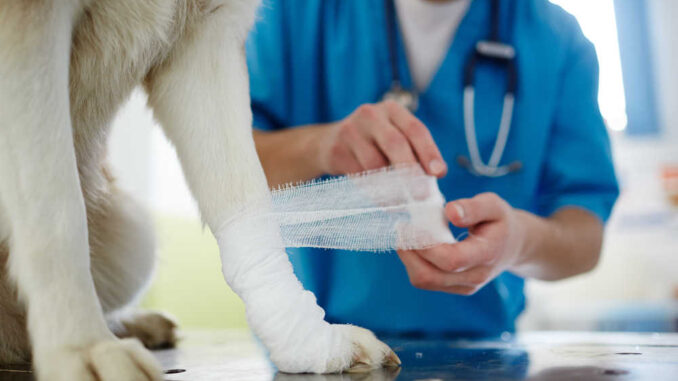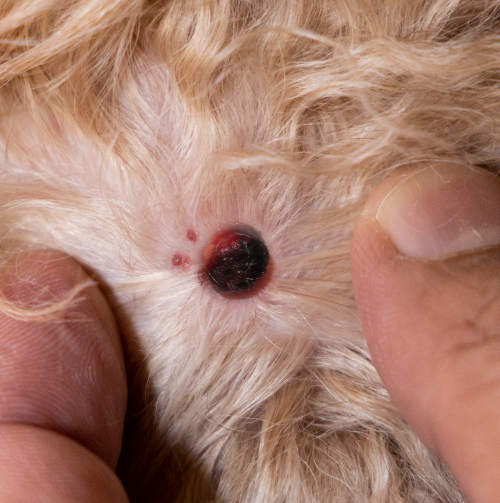
Unfortunately, our dogs are not immune to lumps, bumps, or tumors. They’re actually very common. It’s also fairly common for those same lumps and bumps to bleed periodically. Whether the bleed is directly related to the tumor type or to your dog scratching or nibbling the lump, seeing blood can be troubling. Don’t worry, we’re here to help! In this article, we will look at what can be done to help your dog.
What Happens When a Tumor or Lump Bleeds?
There are different situations:
1. There are some types of tumors that bleed because they are actually coming from blood vessels.
2. There are tumors or lumps that bleed because the skin covering them gets disrupted. This is often because the tumor is causing your dog some discomfort, and they start to scratch or chew at it.
Of course, the first reason is more of a concern than the second reason, but both are alarming.
“If a tumor or lump bleeds an excessive amount, your dog may be in immediate danger. If it just bleeds small amounts over time, there’s not immediate danger, but it does open them up to the chance of infection and other issues.”
What Can You Do At Home to Stop a Bleeding Tumor on a Dog?
Whether your dog has a new lump or a previously diagnosed tumor, when it starts to bleed, it can be very alarming. Fortunately, there are some things you can do to make your pup more comfortable.
- Stay calm. Seeing blood can elicit some fear and get your adrenaline pumping, so take a big deep breath and then find out where the blood is coming from.
- If you can, apply pressure to the bleeding with a towel or other absorbent material. If the lump is in a good area, try to snuggly wrap it.
- Call your veterinarian. Maybe this is the first time or the 31st time your dog has had a bleeding tumor or lump, but your vet will want to know about it. They may ask you to come immediately if there’s a lot of blood or give you the next available appointment if you’re able to get it under control.
- Keep the lump covered until your veterinary appointment to help prevent further bleeding and to keep it clean.
One dog owner asked us: “I just noticed a lump on my dog and it’s bleeding. How do I find out if it’s a cancerous lump? Do dog benign tumors bleed?”
The only way to know what makes up a lump is by visiting your vet. They will take a sample of the lump to find out if it is cancerous or not. Just looking at a tumor or seeing it bleed will not tell you if it’s cancerous or not since benign tumors can also bleed.
What Will My Veterinarian Do For My Dog With a Bleeding Tumor or Lump?
“Hopefully your quick and careful at-home care has gotten your dog’s bleeding lump under control before you get to the vet’s office. If not, that will be the first thing your vet will tackle. From there, they will decide how to fix this issue permanently. If the lump is previously undiagnosed, your vet’s going to want to find out what it is. They will take a sample of it either with a needle and syringe or by biopsy and analyze the results. “
Some samples may need to be sent to another lab for proper diagnosis. Learn more about the costs of FNAs and biopsies.
With any luck, the tumor or lump is small enough and in a favorable spot to just remove-get it out of there so that it can’t bleed anymore.
If the lump is in a spot where surgery isn’t an option, cryotherapy or electrocautery may be tried. For cancerous tumors, chemotherapy or radiation may be discussed as well.
Types of Bleeding Tumors in Dogs
Any tumor or lump in the skin can bleed, especially if your dog is bothered by it and scratches or chews on it. Tumors and lumps can also bleed if they are big enough to get caught and torn on something.
That being said, there are some tumor types that can bleed because that’s the type of tumor they are. These types of tumors tend to be more worrisome because of the risk of bleeding excessively to the point that it’s dangerous for the pup.
Hemangiosarcomas
This is a type of tumor that comes from the blood vessels. They can happen anywhere on the body, and as you can imagine, are capable of bleeding because, well, they’re made up of blood vessels. Hemangiosarcomas are the malignant type of this kind of tumor in that they have a tendency to spread to other areas. They are a high-risk type of tumor because of their spreading capabilities and the chance that they could cause excessive bleeding at any time.

Hemangiosarcomas arise from a mix of genetics and environmental factors. Tumors can pop up on internal organs and will only show up as signs of weakness, paleness, or collapse if they start to bleed. Tumors on the skin can show up as purplish-reddish bumps or swellings on or under the skin. They may bleed spontaneously. The best treatment for hemangiosarcoma is surgical removal +/- chemotherapy if the cancer has already spread.
Hemangiomas
Hemangiomas are just like hemangiosarcomas minus the spreading capability. This means that they are benign tumors but can still be serious. Hemangiomas also come from blood vessels anywhere in the body and can spontaneously (and dangerously) bleed. They can show up on internal organs, not causing any signs until they start to bleed, or they can show up as red bumps on the skin. Either way, your vet will diagnose using a biopsy or take a sample with a needle to analyze under the microscope.
Hemangiomas should also be removed surgically to prevent any bleeding, but the prognosis is much better than with hemangiosarcomas since they don’t spread to other areas.
Others
Let’s just say this one more time: any tumor or lump can bleed. It doesn’t take a specific type. Skin tags, warts, fatty tumors, or mast cell tumors can all bleed, especially if your pup is worried by them and overlicks, scratches, or nibbles at them.
FAQs
How do you know if a bleeding tumor or lump is an emergency?
If you know that your dog has a vascular tumor like a hemangioma or hemangiosarcoma, bleeding can be very detrimental, so seek veterinary care as soon as possible. If your dog has another tumor type that is bleeding and you aren’t able to get the bleeding under control by applying pressure, get emergency care.
What does it mean when a tumor or lump on a dog bleeds?
Vascular tumors may bleed spontaneously because they come from blood vessels, and any extra pressure or bump can set them to bleeding. Other tumors can bleed if they are scratched, chewed, or scraped. This usually means that they are in a spot that is bothering your dog or that they are painful, and they want them gone.
Does a bleeding cancerous tumor impact my dog’s life expectancy?
This depends on the type of cancerous tumor that your dog has. Vascular tumors that bleed can be life-threatening, especially if they’re internal. Other types of tumors may bleed and not have any impact on life expectancy. Be sure to have any lump or bump looked at by a vet to determine what it is and what to do about it.
What happens when a tumor or lump bleeds?
There are a few tumors out there that actually come from blood vessels. These are dangerous tumors to bleed because they have a huge blood supply backing them, making it possible for a dog to lose a lot of blood very quickly. Other tumors can also bleed, especially if they’re bothersome to your dog and they scratch or chew on them, causing a bleeding wound. These tumors are less likely to cause excessive blood loss but can make quite a mess and then become infected.
Are bleeding tumors painful for dogs?
Some tumors can be painful, especially if they’re in an area that sees a lot of movement, such as the groin or armpit, or where they may get easily irritated.
Disclaimer: This website's content is not a substitute for veterinary care. Always consult with your veterinarian for healthcare decisions. Read More.



Our dog N is bleeding out alot and no vet available it’s Saturday night (11:58) we need help
I am so sorry to hear this. I’m afraid this is not an emergency response service, and I hope you’ve been able to get your dog the help they need.
Depending on where you are in the world, this is usually going to mean contacting a local out of hours service. Many private vets offer this service and would advertise the closest one on their website. In some countries, these vet hospitals are located in universities.
You don’t say where your dog is bleeding from exactly, but if it is a tumour, you should apply firm pressure with a clean cloth.
You also want to keep their heart rate low, so staying calm and keeping them as still as possible.
As you say though, a vet trip is needed as they may need e.g. emergency surgery, bandaging, oxygen and/or Intravenous fluids or a blood transfusion. I do hope all is ok.
My 14 yr old dog has a ruptured mammary tumor that is quite large. I’ve seen the vet already and didn’t get a lot of answers except she is old, all we can do is make her comfortable until the inevitable euthanasia. Do you have any suggestions on how clean and or bandage a groin mammary tumor. What’s safe to use? What not to use? Thanks for your time.
I am so very sorry to hear about this. When it comes to a large and inoperable mass, there is a real concern once it has ‘ruptured’ or ulcerated. This can cause considerable discomfort for the dog, and usually these tumours are infected. We can manage these patients palliatively with medicines such as antibiotics, pain relief and anti inflammatories. We also want to regularly clean the mass with saline or dilute Chlorhexidine, and to prevent licking (which may mean using a buster collar or pet t-shirt). Bandaging can be problematic, as if there is an infection, the moist and humid conditions created by a bandage can make this worse. Sadly, with mammary tumours that cannot be excised and that are affecting quality of life, we do need to consider putting the dog to sleep, to prevent any suffering. This is especially true if the mass is causing pain, affecting mobility, bleeding or chronically infected.
“The information on this website is not a substitute for in-person veterinary care. Always seek advice from your veterinarian if you have concerns about your pet’s medical condition.”
if my dog will not stop trying to chew on it and it opens up and bleeds and get infected. it is located in the middle of a long tail. can the tail be ‘bobbed’ to remove the tumor and the portion of the tail it is attached to? my vet didnt even offer this as an option… WHY ?
I’m sorry to hear about this, it sounds very worrying for you.
If the tumour cannot be excised, with healthy tissue left around it, then amputation above the tumour is an option, yes.
The treatment of choice would be tumour excision (assuming it is a cancerous tumour that needs to be excised), but when this is not possible, amputation is reasonable.
I cannot speak for your vet, so please discuss options directly with them, and they can guide you, while taking into account your pet’s medical history and the type/location/size of the growth.
“The information on this website is not a substitute for in-person veterinary care. Always seek advice from your veterinarian if you have concerns about your pet’s medical condition.”
Our dog has a tumor protruding out of his rectum. He is able to pass some stool but takes significant time to go. This tumor bleeds often and he has anal leakage on top of that. I feel he is very uncomfortable, my husband (it is his dog prior to us getting together) does not feel he is miserable and refuses to him to sleep. We are using dog diapers and other absorbent items to try and prevent leaking on the carpet but it only catches about 85% and he does leak blood and other bodily fluids as well. I am at a loss of what to do. Tonight he bled a lot from his tumor in the diaper and a lot when I was cleaning him up.
Hi there. I am so very sorry to hear about this sad situation.
It may be useful for you to look at things objectively, by filling in this questionnaire that focuses on quality of life: https://journeyspet.com/pet-quality-of-life-scale-calculator/
This tumour may be causing discomfort, and there is high risk for infection here.
It may be worth booking a check up with your local vet, to assess your dog in person and talk about options. Euthanasia would be something to consider, if surgical removal is not an option. Otherwise, they may discuss palliative care such as anti inflammatories, pain relief and/or antibiotics.
“The information on this website is not a substitute for in-person veterinary care. Always seek advice from your veterinarian if you have concerns about your pet’s medical condition.”
My 13 year old dog has a mass on her lower ear. We had her groomed at the vet last week and they cleaned the mass and taped it up and wrapped it. Blood was coming thru the wrapping so my mom and I removed the tape. It is completely open now and is an open wound. It stops bleeding but then if she shakes her head or today scratched her ear it gushes. We have tried to wrap it with medical gauze and bandages but she just shakes it off. She’s just so happy still that it’s hard to imagine just giving up. Any suggestions for a dog momma who isn’t ready to let her go? 😭 thank you
Oh, bless her, I’m sorry to hear about this.
When a mass is bleeding, there is a risk of infection, and it does interfere with day to day life.
Is there a reason it cannot be surgically removed? I appreciate she is a senior girl, but age alone would not be reason to forego anaesthesia and surgery. I’m not sure if you’ve discussed this with your vet, but usually ear masses can be safely removed.
The alternative would be palliative care, whereby we manage infections with antibiotics and stem bleeding with pressure wraps. You can buy a ‘No Flap’ ear cover, also known as a Head Cover, which should be kept on.